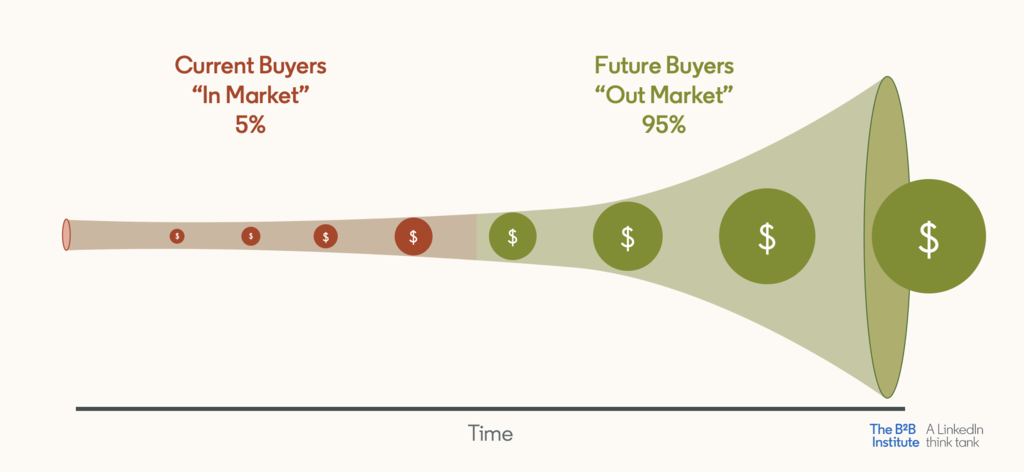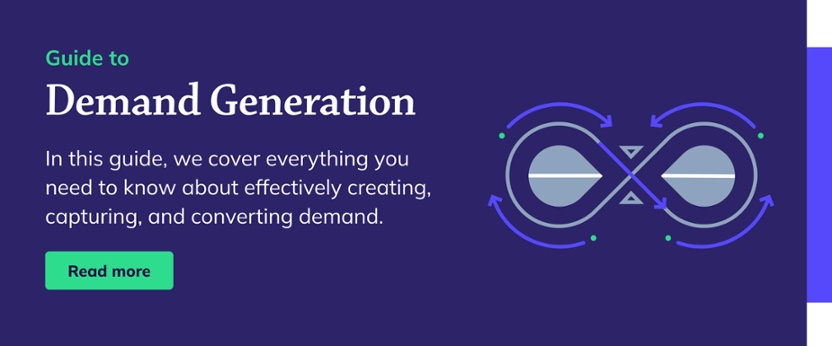B2B buyers aren’t as receptive to traditional lead generation and nurturing tactics as they once were. With so many ways to freely access and consume content, buyers are less willing to hand over their details.
Succeeding in today’s buyer-focussed marketing landscape requires a shift in mindset to one that focuses on creating demand in your offering before you try to capture it.
This article dives deeper into the demand creation vs demand capture debate. We outline the main differences between the two stages and provide practical advice to help you develop your approach to B2B demand generation.
What is demand creation?
At any given time, as much as 95% of your addressable market isn’t actively looking to buy a product or service – yet! The goal of demand creation is to raise awareness of a problem or pain point that your ideal buyer might not know they have and educate them on the available solutions.
How do you create demand?
There are two stages to demand creation:
- Raise awareness of a problem
- Create demand for a solution
Raise awareness of a problem
Create and distribute educational content that makes potential buyers aware of a specific problem, while establishing yourself as a subject matter expert at the same time. Focus on non-intent channels, like social media. This is where your ideal buyers hang out to connect with their peers and consume content. They aren’t actively looking for a solution.
The content that resonates at this stage typically includes:
- Podcasts
- Live events/webinars
- Videos
- In-feed social content
Do some market research to pinpoint the content types that resonate most with your ideal buyer. Or look for an agency that can help you with inbound demand generation.
Create demand for the solution
Provide free, unbiased advice to help potential customers research and find the solution that works for them. Lead with educational content, rather than your products or services. At this stage, buyers are more interested in finding an authoritative, unbiased, and trustworthy source of practical advice than learning about specific features of a product or service.
This approach builds brand affinity with your ideal buyers. So, when they’re ready to purchase a solution, you’re the first brand they think of.
Good demand creation content includes:
- Blogs/articles
- Pillar pages
- Guides
Due to it's lack of direct attribution, demand creation is typically the part that more traditional marketing teams struggle to get to grips with most. If you have the budget, working with a proven b2b demand generation agency can help set you on the right path.
Remember... Up to 95% of your addressable market isn’t looking to buy.
How do you measure demand creation?
Marketing attribution
Marketing attribution tells you which touchpoint leads to visitor engagement. For example, organic search or social media. There are two ways to approach marketing attribution:
- Software attribution. Marketing platforms, like HubSpot, have built-in attribution features that show you how contacts engage with your content and website. However, the problem with this approach is that prospects only spend 17% of the buyer’s journey on brand channels. In other words, 83% of the journey is invisible to your attribution software.
- Self-reported attribution. This is when you include a question on a high-intent conversion form that asks buyers directly how they heard about you. Self-reported attribution makes it easier to pinpoint what specifically attracted a potential buyer to your offering.
What is demand capture?
Demand capture focuses on attracting and converting the roughly 5% of your target market that is actively looking for a solution into pipeline. To do this effectively, you must know which channels your prospects use when they’re ready to buy.
Common demand capture channels are:
- Search engines
- Paid ads
- Review sites, like G2, Capterra, and SaaSworthy
How do you capture demand?
Capturing demand effectively is all about visibility and customer experience. You want to have a strong presence in the right channels and provide a clear, logical conversion path for your buyers.
One way to do this is to create a content marketing strategy that focuses on buyer-intent keywords. This ensures that your commercial pages are the first thing potential buyers see when they’re ready to make a purchase.
You can also use PPC to target the buyer-intent keywords if you're unable to rank for them organically. For review sites, you can often pay to promote your listing and give your business extra visibility.
The demand capture process doesn’t stop when someone reaches your site, however.
To turn opportunities into pipeline, provide a smooth user journey that makes it easy for potential buyers to find what they’re looking for. The best way to do this is to remove any unnecessary hurdles from your conversion path. As such, a well-designed, high-performance B2B website is essential.
How do you measure demand capture?
Marketing qualified leads
A marketing qualified lead (MQL) describes anyone who converts on a high-intent, bottom-of-the-funnel offer or contact form. For example, a demo or consultation request. They’ve expressed a clear interest in your offering and are ready to talk to sales.
This is slightly different to a typical MQL, which uses lead scoring to predict when a potential customer is ready to buy.
Marketing-generated opportunities
Opportunities are MQLs that have become opportunities in your pipeline that came from a marketing source.
Calculating the percentage of MQLs that become opportunities tells you if you’re attracting the right kind of buyer. A high percentage indicates you’re on the right track, a low percentage suggests there are areas you can improve in your demand generation strategy, messaging, or customer journey.
Marketing-generated revenue
Marketing-generated revenue sits between an MQL and a closed/won sale. Often considered the domain of sales, marketing-generated revenue tells you how successful you are at converting MQLs into customers.
Alongside marketing attribution, this helps you identify your most successful revenue channels, so you know where to invest your marketing budget.
Roughly 5% of your target market is actively looking for a solution.
Demand creation vs demand capture – the benefits of a combined approach
Demand creation and demand capture aren’t opposing concepts. They’re two parts of a greater whole: demand generation.
Inbound demand generation is a unified commercial strategy that raises awareness of and increases interest in your offering. It’s a natural evolution of B2B inbound marketing built on the principle that most of your market isn’t ready to buy.
Mastering both aspects of demand generation allows you to create valuable, educational content that empowers buyers to define problems and research solutions in their own time. In today’s buyer-centric marketing landscape, demand generation has become the most effective way to attract potential customers and fuel your pipeline.








